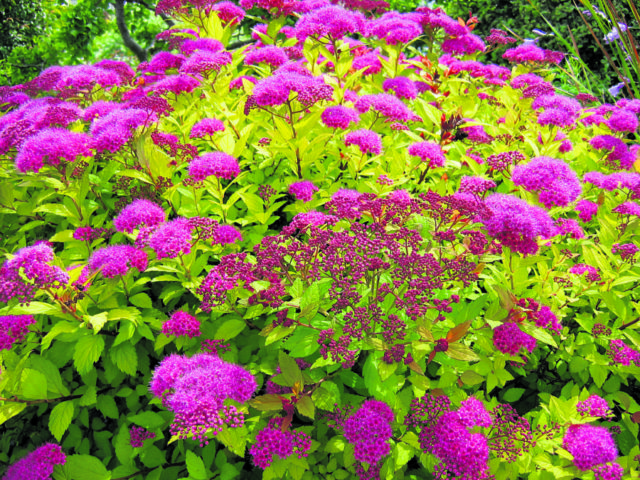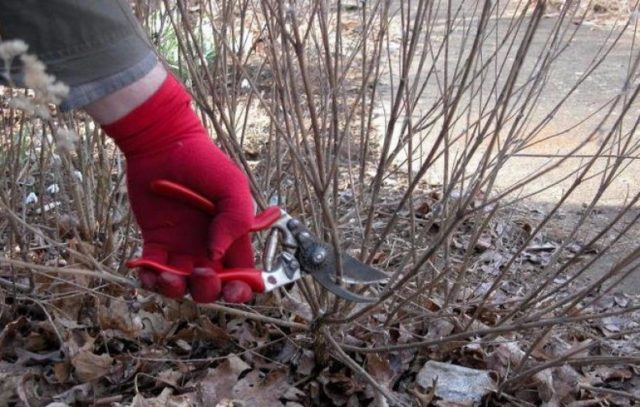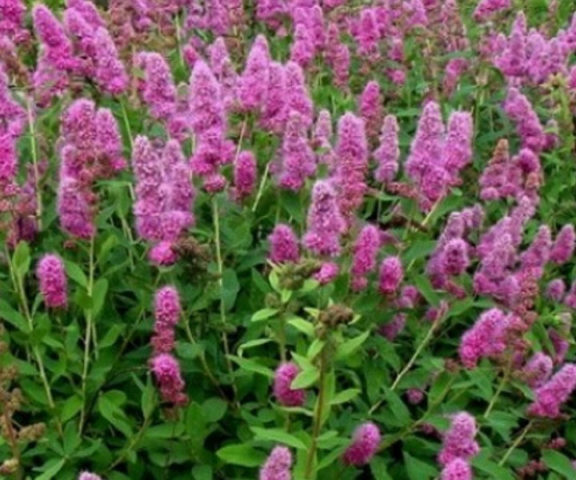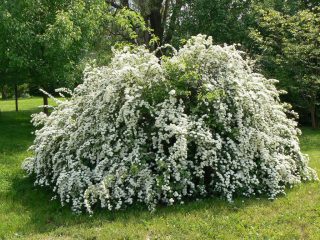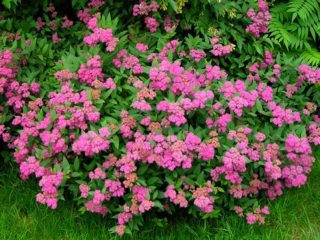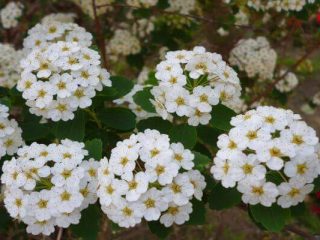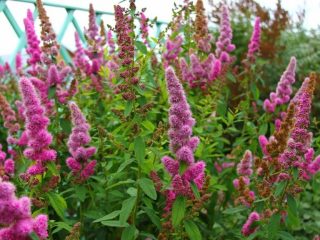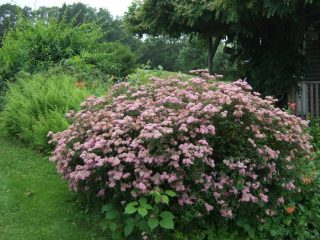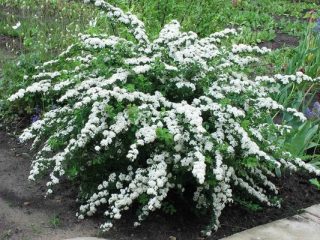Content
Spiraea loosestrife is an interesting ornamental plant. The botanical name comes from the ancient Greek word “speira”, which means “bend”, “spiral”. This is explained by the fact that long, flexible branches give the shrub additional splendor. The second word in the name is derived from the shape of the leaves, which are similar in appearance to willow leaves. A description and photo of willow spirea will be presented below.
Description of willow spirea
Spiraea willow is a deciduous shrub. Belongs to plants of the Spiraea genus, Rosaceae family. The root system is shallow and fibrous. The foliage is elongated-lanceolate. The apex is pointed. The surface of the leaf is smooth. Petioles are short. The base is wedge-shaped. The sharp-serrated edges may have cilia. The outer side of the leaf is dark green, the inner side is light green. The length is usually 5-7 cm, rarely reaching 10-11 cm, and the width is 1-3 cm.
The perennial has high frost resistance. Demanding on moisture and sun. Grows in soils of various compositions.The bush grows quickly. In the natural environment it is found in swampy areas, on river banks, and water meadows. Grows in North America, China, Korea, Japan.
Plant sizes
The willow spirea reaches a height of 1.5-2 m. The crown is spherical. The branches are bare. Slightly faceted, have a vertical orientation. Young shoots have a yellow, light green color. More mature branches are dark red, brown.
Medicinal properties of willow spirea
Spiraea willow is not only beautiful, but also useful. Leaves, young shoots, inflorescences, bark, buds, and roots are used in medicine. The plant contains tannins, flavonoids, phytoncides, alkaloids, vitamins A, C, essential oil, salicylic acid, mineral salts. Thanks to its rich chemical composition, willow spirea has the following properties:
- antimicrobial;
- anti-inflammatory;
- antipyretic;
- anthelmintic;
- antifungal;
- wound healing;
- painkiller.
Decoctions and tinctures of Spiraea loosestrife are used as medicinal products in folk medicine. They help with diarrhea, rheumatism, and intestinal candidiasis.
When it blooms
Willow spirea blooms in the second half of June and ends in early autumn. Flowers bloom unevenly. The process can last up to one and a half months. Inflorescences form on the shoots of the current year. They have a narrow pyramidal shape, similar to a cylindrical one. They consist of small flowers with yellowish pedicels, collected in a bunch. Panicles form along the edges of the shoots. The approximate length of the inflorescences is 12-25 cm.
The shrub is valued for its bright pink blooms. There are also lilac, pomegranate, and burgundy shades of inflorescences. Rarely, white willow spirea is found.
Fruit type
The fruits of the willow spirea look like multi-seeded leaflets. The opening occurs first along the inner and then along the outer edge. The seeds are flat, winged, brown in color. Ripening occurs in 45-60 days. The seeds fall out of the leaflets.
Spiraea in landscape design
The decorativeness and attractiveness of the willow spirea continues throughout the season. The expressive shape of the crown and long flowering make it an indispensable element of the landscape composition. This type of shrub is used in the form of a dense hedge. Pink willow spirea will look no less impressive when planted alone. The plant is used as decoration when creating an alpine slide.
Planting and caring for willow spirea
Despite its visual attractiveness, willow spirea is unpretentious in care. It grows and blooms well under the most ordinary conditions. The only thing worth paying attention to is pruning the plant.
Preparation of planting material and site
For planting, it is advisable to choose 1-2 year old seedlings, which can have an open or closed root system. Before planting a plant with closed roots, it is removed from the container along with a lump of earth. Afterwards moisturize generously. If the earthen lump is too dry, then you need to soak it briefly in warm water.
Saplings with exposed roots should be tidied up. The first step is to trim damaged or dry areas. Excessively branched roots also require pruning. The above-ground part is shortened by 1/3 of the length. To improve survival rate, the root system of a loosestrife spirea seedling is dipped in a mixture of clay and cow dung.
For willow spirea, sunny, open areas are selected. The plant can also grow in partial shade, but the flowering will not be as abundant. The composition of the soil does not matter. It is preferable that it be fertile, loose and moist. The ideal option is turf or leaf soil. The required pH is 6-7.
Planting willow spirea
For planting willow spirea in open ground, 2 seasons are suitable: spring and autumn. In the spring, it is important to plant the plant before the buds appear on the seedling, in the fall - after the leaves have dropped. When using group planting of spirea, the distance between plants should be 50 cm. The presence of lime in the soil is unacceptable.
- In the selected area, dig a hole 50 cm deep.
- The recess should be larger than the diameter of the root system. In this case, the bush will develop faster.
- A drainage layer of broken brick, crushed stone or expanded clay, 15 cm thick, is laid on the bottom.
- Fill the bottom of the hole with garden soil mixed with peat and sand in a ratio of 2:1:1.
- A sapling of willow spirea is placed in the center of the recess and sprinkled with earth. The root collar is not deepened too much; it should be 3-5 cm above the ground surface.
- The soil around the roots is carefully poured and compacted.
- At the end, 1-2 buckets of warm water should be poured under each bush.
- At the end of planting, the circle around the trunk is mulched with peat.
Watering and fertilizing
Spiraea loosestrife is a drought-resistant plant that requires moderate watering. On average, 15-20 liters of water per week is sufficient for an adult crop.During hot periods, the amount of watering should be increased. Young shrubs need more frequent watering until they take root. However, it is important to ensure that there is no stagnation of liquid.
The optimal time for fertilizing is early spring, before the flowering of willow spirea. Fertilize it with a complex of mineral and organic substances. To do this, dilute 10 liters of mullein in 6 liters of water. Then 7-10 g of superphosphate is added to the bucket of the resulting mixture.
Trimming
The pruning procedure for willow spirea is carried out at the end of flowering, that is, in the fall. However, there is no need to shorten faded shoots, as this will provoke the growth of lateral branches, on which small, inexpressive flowers will appear. The shape of the bush will also be disrupted, and the effect of flowering shoots drooping to the bottom will be spoiled.
Summer-flowering spirea begin to be pruned with the arrival of spring, and only those plants that are at least 4 years old. As a result, the bush will remain 20-30 cm tall. If this is not done, then the willow spirea will lose its decorative shape, the long branches will deviate to different sides, leaning towards the ground. And if you remove only the upper part of the shoots, then the young shoots will be extremely thin, with inflorescences of insignificant size.
Preparing for winter
As a rule, willow spirea does without shelter in winter. It can tolerate frosts down to -45-50 °C. However, if a harsh and snowless winter is expected, then it is worth providing the plant with proper wintering. The circle around the trunk is mulched with hay or straw, the roots are covered with dry spruce branches. The branches are tied into a bundle and covered with burlap or agrofibre.
Reproduction
Spiraea loosestrife propagates in 3 main ways: cuttings, layering and seeds.
- Seed material is planted in seedling boxes in March-April. After 10-12 days, the first shoots will appear, and after 2-3 months the seedlings are picked and planted in open ground. Young spirea will actively develop if simple agrotechnical measures are followed. The bush will bloom for 2-3 years.
- To preserve all varietal characteristics, the cutting method should be used. Plants grown this way bloom much faster. The willow spirea will be covered in flowers for the next season. Partially woody shoots of the current year are used as planting material. Areas 10-15 cm long are required. The lower part of the cutting is dipped in a rooting preparation and planted in the ground. If the procedure is performed in July, then by autumn a full-fledged root system will appear.
- The following propagation method is used if few young plants are required. To do this, during the period of leaf blossoming, the side branches need to be bent to the ground. Pin them with pegs and cover them with soil. During the season, maintain a moist environment around the branches and by autumn you can get independent plants.
Diseases and pests
The shrub has strong immunity to various bacterial and fungal diseases. However, pests cause great damage to the plant: spider mites, aphids, roseate leaf rollers, slugs, and pink miner.
Proper care of the willow spirea helps to cope with them: watering, fertilizing, loosening the soil, pruning, and also keeping the area clean.The fight against harmful insects involves timely treatment with chemicals.
- Spider mite. Its presence is revealed by holes made in the inflorescences, premature drying and falling of leaves. The pest is active in dry, hot weather. 0.2% phosphamide, 0.3% karbofos, 0.2% acrex help to cope with it.
- Leaf roller. Appears at the end of May. The parasite chews out all the green tissue on the leaves. His drug 0.1% pyrimor completely destroys it.
- Aphid. Sucks juice and nutrients from leaves, petioles, and young shoots. The treatment is carried out with a soap and tobacco solution.
Conclusion
Spiraea willow is a real find for the gardener. Numerous options for use and ease of care make the shrub more and more in demand. This culture can decorate not only a personal plot, but also city streets. A novice gardener can grow it.
